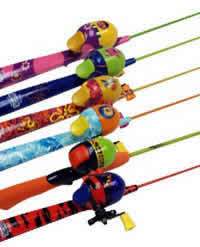Time for a science quiz.
It’s the chemical element with atomic number 5 and the chemical symbol B.
It is a metalloid and its chemically uncombined form is not found naturally on Earth. Give up yet?
Another hint: It was once “all the rage” in the rod building industry, just not in the fancy rods pictured to the left. Figured it out yet?
 Time’s up…remember boron rods? What in the heck happened to those?
There was a time when much like the Kevlar post from last week, boron was the wave of the future, only in rod building. That was back in the early to mid 80’s, but it obviously never caught on in the bassin’ world. You can however buy a very nice high end boron fly rod, usually running somewhere to the tune of about $750. Those NRX’s are looking like a good deal after all.
There are still a few companies that make rods with some boron in them, but the mass production never came to be. Boron ran into a few downfalls along the way, among them:
- High cost – boron typically ran about 8-10 times as much as graphite, so even though a typical rod might only be comprised of 15-25% boron, it added a hefty buck or two to the overall rod cost.
- Difficult to work with – boron is about twice as stiff (modulus) as graphite, and hence didn’t lend itself well to very tight radius bending, something pretty common in shorter, more traditional rods. This isn’t the case in fly rods though.
- Not user friendly – this same stiffness component lead to a rod that wasn’t the most user friendly for a beginning basser. The rods wouldn’t load real well, especially with lightweight baits, and casting would often become a tricky game of timing and feel.
- Brittle/fragile – since boron was a fairly strong material, you could build pretty thin rods that made them prone to damage. Any little scratch or nick could potentially result in a shattered rod upon the next hookset. This also made it cost prohibitive from a warranty standpoint.
Used correctly, boron still makes for a very nice and sensitive rod, usually resulting in a fairly high end bracket of a manufacturers lineup. Some of you might have one of these old rods still sitting around the house somewhere, or even own one of the newer versions available. Yet, it never panned out like the pundits thought it might.


























Rich Arnold
September 26, 2011 at 9:31 am
I remember the Fenwick boron rods. Way back in the early 80s when these bad boys came out, my father and grandfather bought a few. Doubt that boron rods will make a comeback based on the great things rod companies are doing with graphite these days.
admin (mostly Jay)
September 26, 2011 at 11:33 am
Does anyone still make them? Sounds like heavy action jig-type rod would be great.
YankeeBasser
September 29, 2011 at 4:04 pm
Browning makes a boron/graphite composite that is sold through Bass Pro Shops for $100. This is the only ones that I have heard of recently. Anyone else know of any companies making either a hybrid like this or a pure boron rod? I’d be interested to see if advances in technology could improve on the problems associated with the old boron rods, specifically in the area of their being fragile and breaking on a good hookset.